
Chapter 18 Understanding Unfamiliar Code
18.1 Learning Objectives
- Recognize the benefits, limitations, and assumptions in using AI to understand unfamiliar code
- Consider the ethical questions around using AI to understand another person’s code
- Practice using AI to summarize code, identify an unknown coding language, and interpret regex and unknown functions
18.2 Reading Unfamiliar Code Is A Skill
As a programmer, you will frequently encounter situations where you need to read and understand code written by other developers. This could be because you are collaborating on a project, you have taken over maintenance of an existing codebase, or you are learning new syntax or skills that require reading example codes. Comprehending code written by someone else is a distinct skill from being able to write your own code, and it takes practice to become proficient at it.
Reading unfamiliar code is like exploring an unfamiliar city without a map or a guide. Just like in a new city, you may not know where to start or how to navigate the codebase. You may encounter unfamiliar syntax, functions, and libraries that you have never seen before, just as you might encounter new streets, buildings, and landmarks. At first, you may feel disoriented and overwhelmed, and may need to spend some time getting oriented and familiarizing yourself with the environment. As you explore, you may start to see patterns and similarities, just as you might begin to recognize neighborhoods and landmarks in a new city. You may also encounter dead-ends, confusing intersections, and unexpected detours, just as you might encounter bugs and errors in the code.
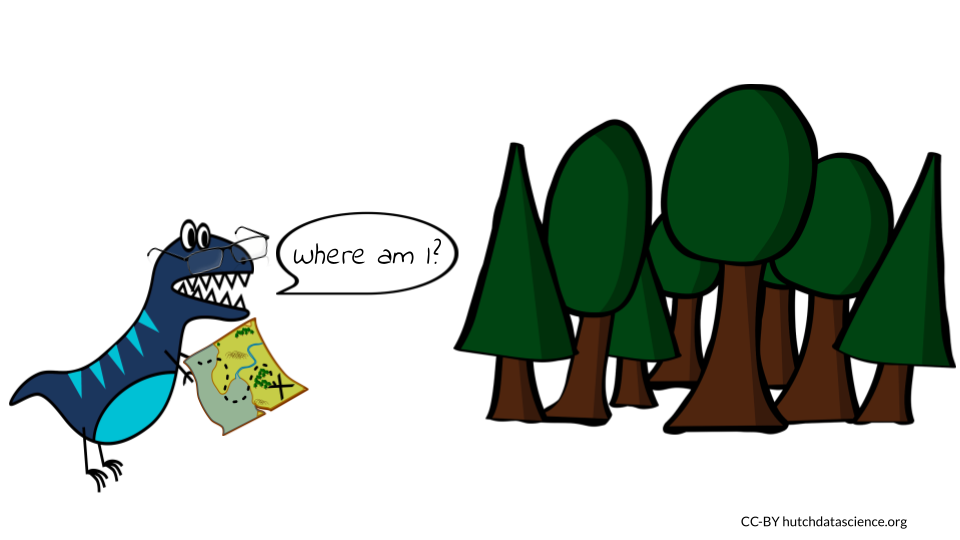
To make progress in this unfamiliar territory, you may need to rely on a combination of intuition, deduction, and experimentation. You may need to break down the code into smaller pieces, analyze the behavior of each piece, and gradually build up a mental model of how the code works. You may also need to consult documentation, online resources, or other experts who are familiar with the codebase, just as you might ask locals or consult a map in a new city.
In the end, with patience, persistence, and a willingness to learn, you can successfully navigate the unfamiliar code and achieve your goals, just as you can successfully explore a new city and discover its hidden treasures. Learning how to read and understand code written by someone else is a valuable skill that can help you be a more effective programmer. By being able to read and comprehend unfamiliar code, you can contribute to projects more quickly, diagnose and fix bugs more effectively, and learn new programming techniques and best practices. As with any skill, the more you practice reading and understanding code written by others, the more comfortable and proficient you will become at it.
The information presented in this course is meant for use with open source code and software. It is unclear what happens to the information fed to AI chatbots as prompts, or how secure the data are. We know data are saved and may be used to further train the AI tools, but the specifics of how data are saved, as well as how sensitive or personally identifiable information are protected, is unknown.
Err on the side of caution when interacting with them. We do not recommend using proprietary code or private information for prompts unless you are working with an AI that you or your company built and you know is secure.
18.3 Example One: Summarizing Code You Didn’t Write
Here’s some simple code using the R programming language, written by an unnamed programmer. If you are familiar with R, you might be able to understand what this code does with little effort. However, if you don’t know R, you’re relatively new to R, or you’re just having a bad day, understanding what this bit of code can take a great deal more energy and time. AI language bots can ease that burden.
library(tidyverse)
d <- ggplot2::diamonds
d_sel <- d %>%
select(carat, cut, color, clarity, depth, table, price)
d_fil <- d_sel %>%
filter(price > 5000)
d_bin <- d_fil %>%
mutate(carat_bins = cut_width(carat, width = 0.2))
d_summ <- d_bin %>%
group_by(carat_bins, cut, color, clarity) %>%
summarize(mean_price = mean(price), sd_price = sd(price))We first ask Claude-instant (as implemented by Poe) to explain the purpose of this code.
What does this code do?
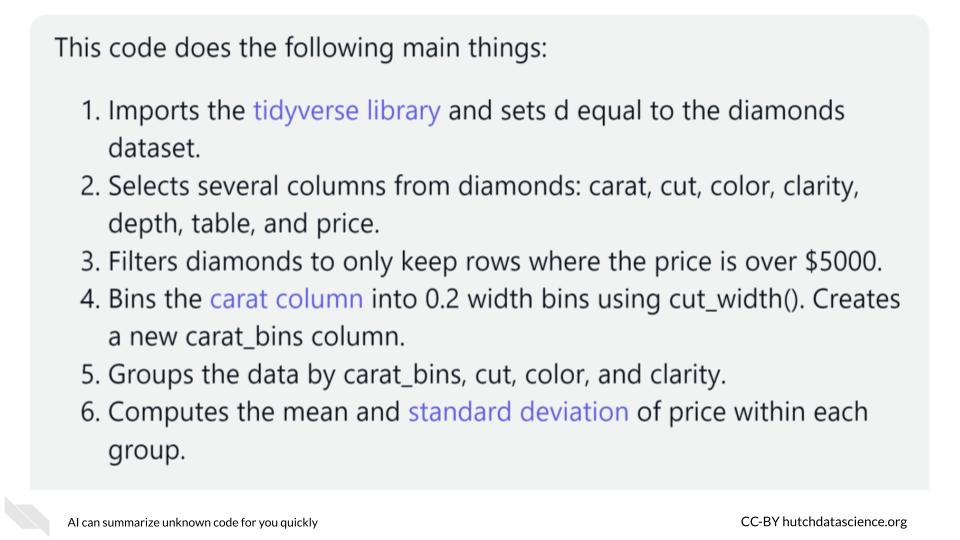
You can ask for Claude to summarize each step in detail as well.
Can you explain what each step does in detail?
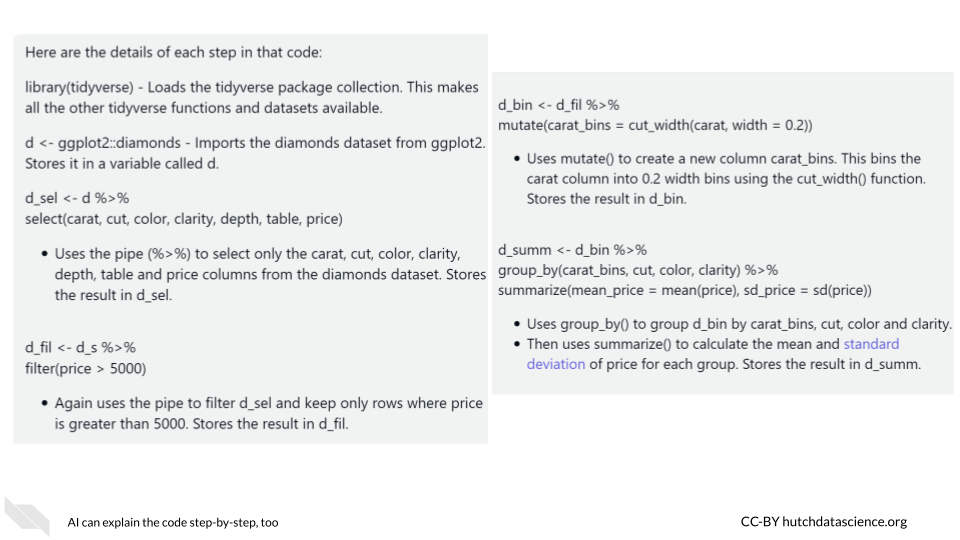
Maybe you’ve never worked with the tidyverse package in R - Claude can tell you about it.
What is the tidyverse package?
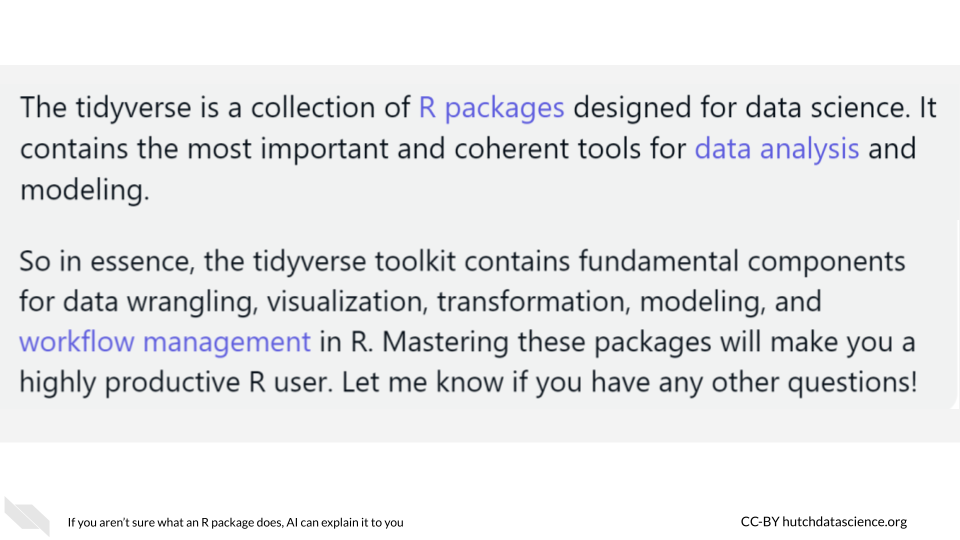
You might also not be familiar with the diamonds dataset (especially if you’ve never used it before) and want some clarification on where the data are from.
Can you tell me more about the diamonds dataset?

18.4 Example Two: Identifying a Coding Language
Sometimes you might have to work with legacy code. Legacy code can be difficult to work with, especially if it is written in a language or style with which you are not familiar. There are more than 700 programming languages in use today, so it is impossible for any programmer to know them all. AI can be a helpful tool for identifying the language and version of legacy code, which can make your life just a little easier.
Let’s look at example code that might have been written decades ago.
program temperature_smog_analysis;
uses
Math;
const
n_temperatures = 1000;
n_smog_measures = 500;
type
TemperatureArray = array[0..n_temperatures-1] of integer;
SmogArray = array[0..n_smog_measures-1] of integer;
var
temperatures: TemperatureArray;
smog_measures: SmogArray;
combined_data: array of integer;
slope, y_intercept: double;
i, j: integer;
function connect_to_database(filename: string): integer;
begin
{ implementation of connect_to_database function }
end;
function retrieve_temperatures(fd: integer): integer;
begin
{ implementation of retrieve_temperatures function }
end;
function retrieve_smog_measures(fd: integer): integer;
begin
{ implementation of retrieve_smog_measures function }
end;
function retrieve_temperature(fd, index: integer): integer;
begin
{ implementation of retrieve_temperature function }
end;
function retrieve_smog_measure(fd, index: integer): integer;
begin
{ implementation of retrieve_smog_measure function }
end;
procedure close_database(fd: integer);
begin
{ implementation of close_database function }
end;We can ask Bard to take a guess at what the coding language might be.
What language is this code written in?
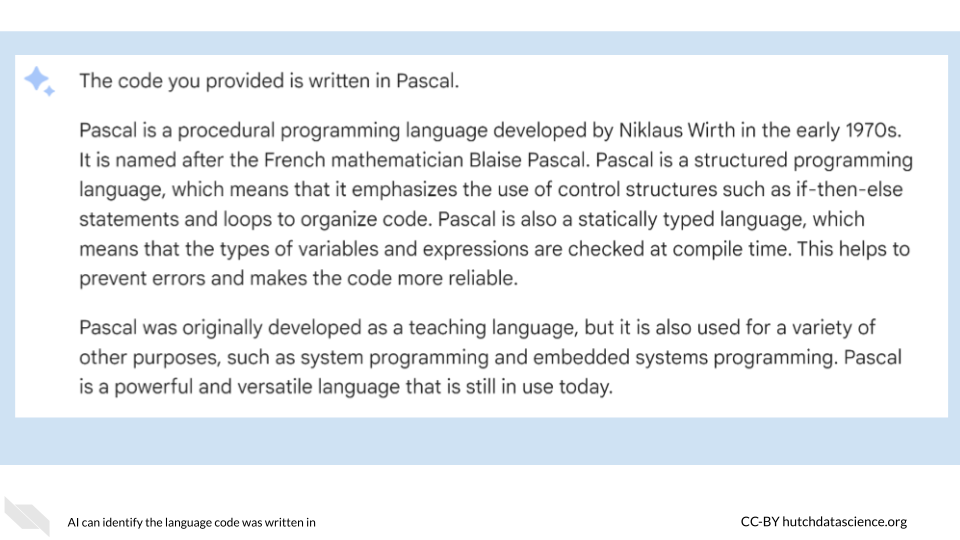
We can explore further to figure out what indicators tell Bard the language is Pascal.
How do you know this is Pascal?
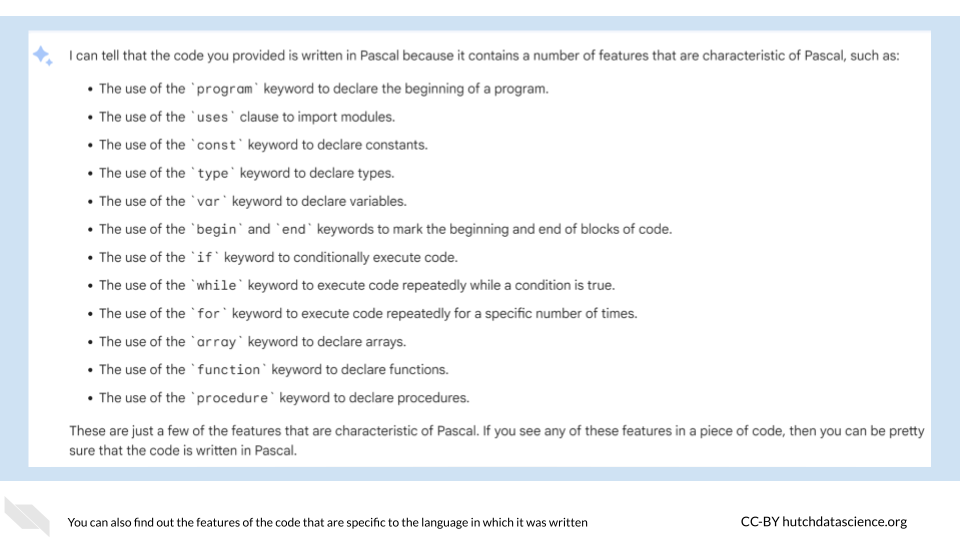
It turns out there are multiple versions of Pascal. Since you will presumably need to work with this legacy code, you might want to know which version it is.
What version of Pascal is this?
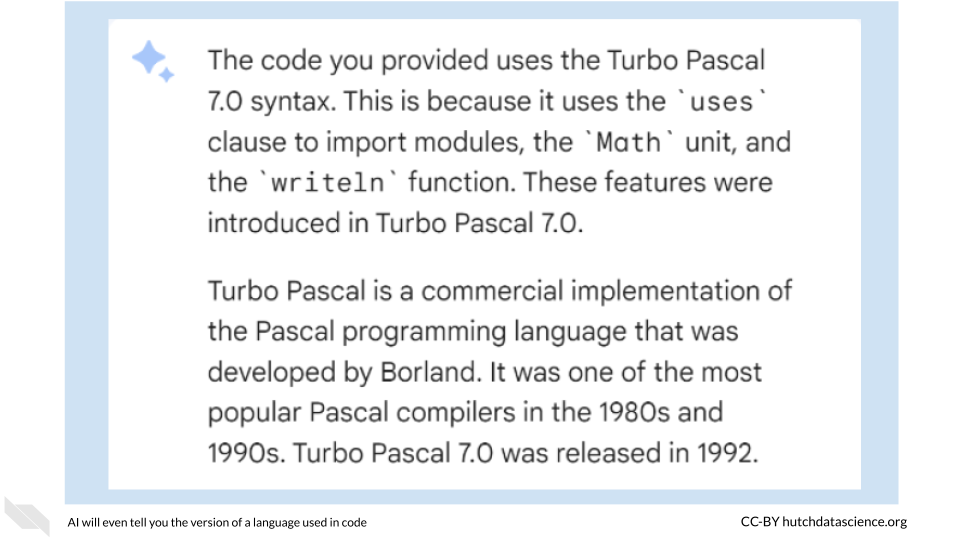
18.5 Example Three: Interpreting Regex
Regex (short for Regular Expressions) is a sequence of characters that define a search pattern. Regular expressions can be a powerful tool for data cleaning, text mining, and data validation. They are widely used in web development, data science, and other fields where text processing is important. They can also be tricky to understand at first because they involve a specific syntax that can be complex.
We can use ChatGPT to explain regex in a bit of someone else’s code.
x = sub("/d/e","/d",x)What does this do?
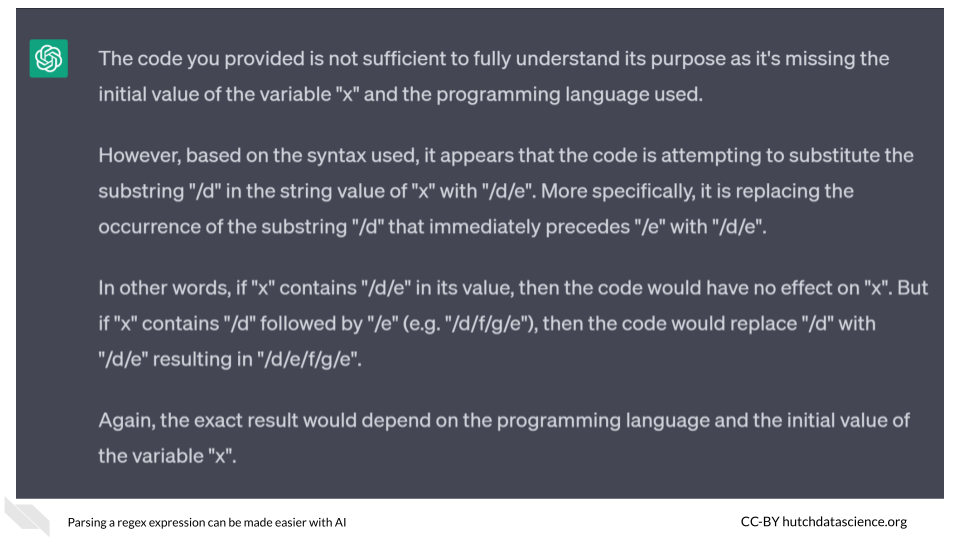
18.6 Example Four: Demystifying Functions
Sometimes we get handed code that includes complex architecture. Perhaps you are working with code you wrote years ago when you really liked loops, but present you finds them difficult to parse. (Be nice to past you - maybe you were a baby programmer and didn’t know better.) Instead of giving yourself a headache, you could turn to ChatGPT to explain what your old code does.
def my_function(x):
result = x
for i in range(10):
for j in range(5):
result = result + 2 * (i + 1) * (j + 1) * (i % 2 == 0 and j % 2 == 0) - 1
return resultWhat does this function do?
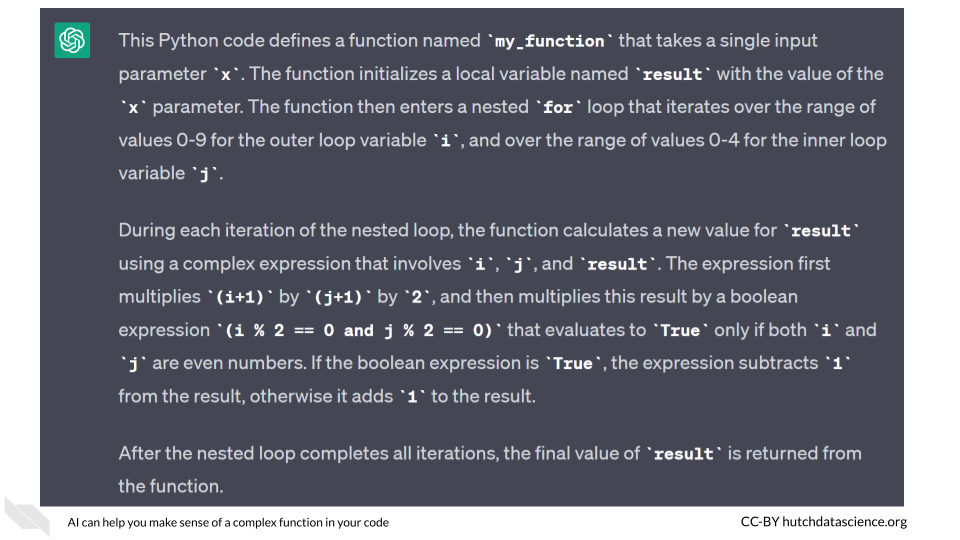
Well, now you have an idea what past-you might have been attempting to do with this code. You can also query AI about the potential problems from using the code as-written.
What are some possible issues with this code?

(And if you do ever run across an expression like this in your code, you can check out our chapter on refactoring code using AI to fix it!)
18.7 Limitations
Although chatbots can be extremely helpful for better understanding someone else’s code, if there is a lack of annotation or documentation, it will be difficult to discern more about the context of the development.
Cases where developers may not have provided context information include:
- Not stating their purpose for writing this code.
- Not describing what they planned to do next.
- Not describing (or being aware of) possible parts of the code that need updating or maybe have security or privacy issues.
- Not describing how they made certain decisions in the development process.
Although we can’t truly understand some of this information, it is however possible to get some assistance from chatbots with prompts such as:
- What do you think the purpose of this code is?
- What might be possible next steps to further develop this code?
- What are possible issues with this code, particularly for security or privacy?
- Why was the code possibly written with this structure? What other options are possible?
Chatbot tools are also limited in terms of how up-to-date their training data is to know about current possible issues with code.
